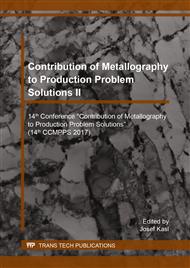[1]
D. Wu, R.S. Chen, W. Ke, Microstructure and mechanical properties of a sand-cast Mg–Nd–Zn alloy. Materials & Design 2014, 58, 324-331.
DOI: 10.1016/j.matdes.2014.01.061
Google Scholar
[2]
K.F. Farraro, K.E. Kim, S.L.Y. Woo, J.R. Flowers,; McCullough, M.B., Revolutionizing orthopaedic biomaterials: The potential of biodegradable and bioresorbable magnesium-based materials for functional tissue engineering. Journal of Biomechanics 2014, 47 (9), 1979-(1986).
DOI: 10.1016/j.jbiomech.2013.12.003
Google Scholar
[3]
F. Witte, The history of biodegradable magnesium implants: A review. Acta Biomaterialia 2010, 6 (5), 1680-1692.
DOI: 10.1016/j.actbio.2010.02.028
Google Scholar
[4]
L.N. Zhang, Z.T. Hou, X. Ye, Z.B. Xu, X. L Bai, P. Shang, The effect of selected alloying element additions on properties of Mg-based alloy as bioimplants: A literature review. Frontiers of Materials Science 2013, 7 (3), 227-236.
DOI: 10.1007/s11706-013-0210-z
Google Scholar
[5]
M.P. Staiger, A.M. Pietak, J. Huadmai, G. Dias, Magnesium and its alloys as orthopedic biomaterials: A review. Biomaterials 2006, 27 (9), 1728-1734.
DOI: 10.1016/j.biomaterials.2005.10.003
Google Scholar
[6]
G.L. Song, A. Atrens, Corrosion Mechanisms of Magnesium Alloys. Advanced Engineering Materials 1999, 1 (1), 11-33.
Google Scholar
[7]
D. Dvorský, J. Kubásek, D. Vojtěch, I. Voňavková, M. Veselý, M. Čavojský, Structure and mechanical characterization of Mg-Nd-Zn alloys prepared by different processes. IOP Conference Series: Materials Science and Engineering 2017, 179 (1), 012018.
DOI: 10.1088/1757-899x/179/1/012018
Google Scholar
[8]
X. Zhao, L. Shi, J. Xu, A Comparison of Corrosion Behavior in Saline Environment: Rare Earth Metals (Y, Nd, Gd, Dy) for Alloying of Biodegradable Magnesium Alloys. Journal of Materials Science & Technology 2013, 29 (9), 781-787.
DOI: 10.1016/j.jmst.2013.05.017
Google Scholar
[9]
M. Peter, Effect of Composition and Microstructure on Mechanical and Corrosion Properties in Magnesium Alloys with a Potential for Medical Applications. Universita Karlova v Praze, (2014).
Google Scholar
[10]
D. Dvorsky, J. Kubasek, D. Vojtech, M. Cavojsky, Structure and mechanical properties of WE43 prepared by powder metallurgy route. Manufacturing Technology 2016, 16 (5), 896-902.
DOI: 10.21062/ujep/x.2016/a/1213-2489/mt/16/5/896
Google Scholar
[11]
G. Song, A. Atrens, Understanding Magnesium Corrosion—A. Framework for Improved Alloy Performance. Advanced Engineering Materials 2003, 5 (12), 837-858.
DOI: 10.1002/adem.200310405
Google Scholar
[12]
Y. Fan, G. Wu, C. Zhai, Influence of cerium on the microstructure, mechanical properties and corrosion resistance of magnesium alloy. Materials Science and Engineering: A 2006, 433 (1–2), 208-215.
DOI: 10.1016/j.msea.2006.06.109
Google Scholar
[13]
A. Pardo, M.C. Merino, A. E. Coy, R. Arrabal, F. Viejo, E. Matykina, Corrosion behaviour of magnesium/aluminium alloys in 3. 5 wt. % NaCl. Corrosion Science 2008, 50 (3), 823-834.
DOI: 10.1016/j.corsci.2007.11.005
Google Scholar
[14]
R. Xin, Y. Luo, A. Zuo, J. Gao, Q. Liu, Texture effect on corrosion behavior of AZ31 Mg alloy in simulated physiological environment. Materials Letters 2012, 72, 1-4.
DOI: 10.1016/j.matlet.2011.11.032
Google Scholar
[15]
R. Xin, B. Li, L. Li, Q. Liu, Influence of texture on corrosion rate of AZ31 Mg alloy in 3. 5 wt. % NaCl. Materials & Design 2011, 32 (8–9), 4548-4552.
DOI: 10.1016/j.matdes.2011.04.031
Google Scholar
[16]
K.D. Ralston, N. Birbilis, C.H.J. Davies, Revealing the relationship between grain size and corrosion rate of metals. Scripta Materialia 2010, 63 (12), 1201-1204.
DOI: 10.1016/j.scriptamat.2010.08.035
Google Scholar
[17]
D. Dvorsky, J. Kubasek, D. Vojtěch, F. Prusa, K. Nova, Preparation of WE43 using powder metallurgy route. Manufacturing Technology 2016, 16 (4), 680-687.
DOI: 10.21062/ujep/x.2016/a/1213-2489/mt/16/4/680
Google Scholar
[18]
D.L. Yin, J.T. Wang, J.Q. Liu, X. Zhao, On tension–compression yield asymmetry in an extruded Mg–3Al–1Zn alloy. Journal of Alloys and Compounds 2009, 478 (1–2), 789-795.
DOI: 10.1016/j.jallcom.2008.12.033
Google Scholar
[19]
P.S. Roodposhti, A. Sarkar, K.L. Murty, H. Brody, R. Scattergood, Grain boundary sliding mechanism during high temperature deformation of AZ31 Magnesium alloy. Materials Science and Engineering: A 2016, 669, 171-177.
DOI: 10.1016/j.msea.2016.05.076
Google Scholar
[20]
C. Wang, M. Sun, F. Zheng, L. Peng, W. Ding, Improvement in grain refinement efficiency of Mg–Zr master alloy for magnesium alloy by friction stir processing. Journal of Magnesium and Alloys 2014, 2 (3), 239-244.
DOI: 10.1016/j.jma.2014.09.001
Google Scholar
[21]
J. Kubásek, D. Dvorský, M. Čavojský, D. Vojtěch, N. Beronská, M. Fousová, Superior Properties of Mg–4Y–3RE–Zr Alloy Prepared by Powder Metallurgy. Journal of Materials Science & Technology 2017, 33 (7), 652-660.
DOI: 10.1016/j.jmst.2016.09.019
Google Scholar
[22]
M. G. Jiang, H. Yan, R.S. Chen, Twinning, recrystallization and texture development during multi-directional impact forging in an AZ61 Mg alloy. Journal of Alloys and Compounds 2015, 650, 399-409.
DOI: 10.1016/j.jallcom.2015.07.281
Google Scholar
[23]
M.G. Jiang, C. Xu, T. Nakata, H. Yan, R.S. Chen, S. Kamado, Rare earth texture and improved ductility in a Mg-Zn-Gd alloy after high-speed extrusion. Materials Science and Engineering: A 2016, 667, 233-239.
DOI: 10.1016/j.msea.2016.04.093
Google Scholar
[24]
Y.P. Wu, X.M. Zhang, Y.L. Deng, C.P. Tang, Y.Y. Zhong, Effect of compression conditions on the microstructure and texture of a Mg–RE alloy. Materials Science and Engineering: A 2015, 644, 152-158.
DOI: 10.1016/j.msea.2015.07.064
Google Scholar
[25]
H. Windhagen, K. Radtke, A. Weizbauer, J. Diekmann, Y. Noll, U. Kreimeyer, R. Schavan, C. Stukenborg-Colsman, H. Waizy, Biodegradable magnesium-based screw clinically equivalent to titanium screw in hallux valgus surgery: short term results of the first prospective, randomized, controlled clinical pilot study. BioMedical Engineering OnLine 2013, 12 (1), 62.
DOI: 10.1186/1475-925x-12-62
Google Scholar
[26]
Y. Zong, G. Yuan, X. Zhang, L. Mao, J. Niu, W. Ding, Comparison of biodegradable behaviors of AZ31 and Mg–Nd–Zn–Zr alloys in Hank's physiological solution. Materials Science and Engineering: B 2012, 177 (5), 395-401.
DOI: 10.1016/j.mseb.2011.09.042
Google Scholar



